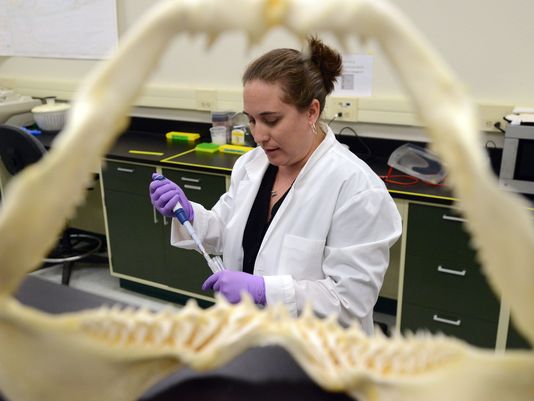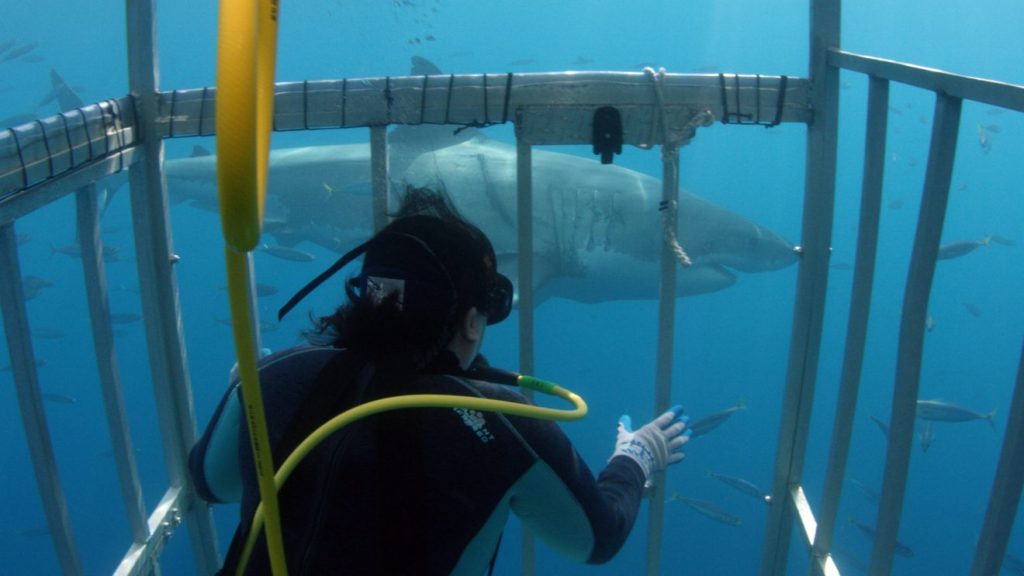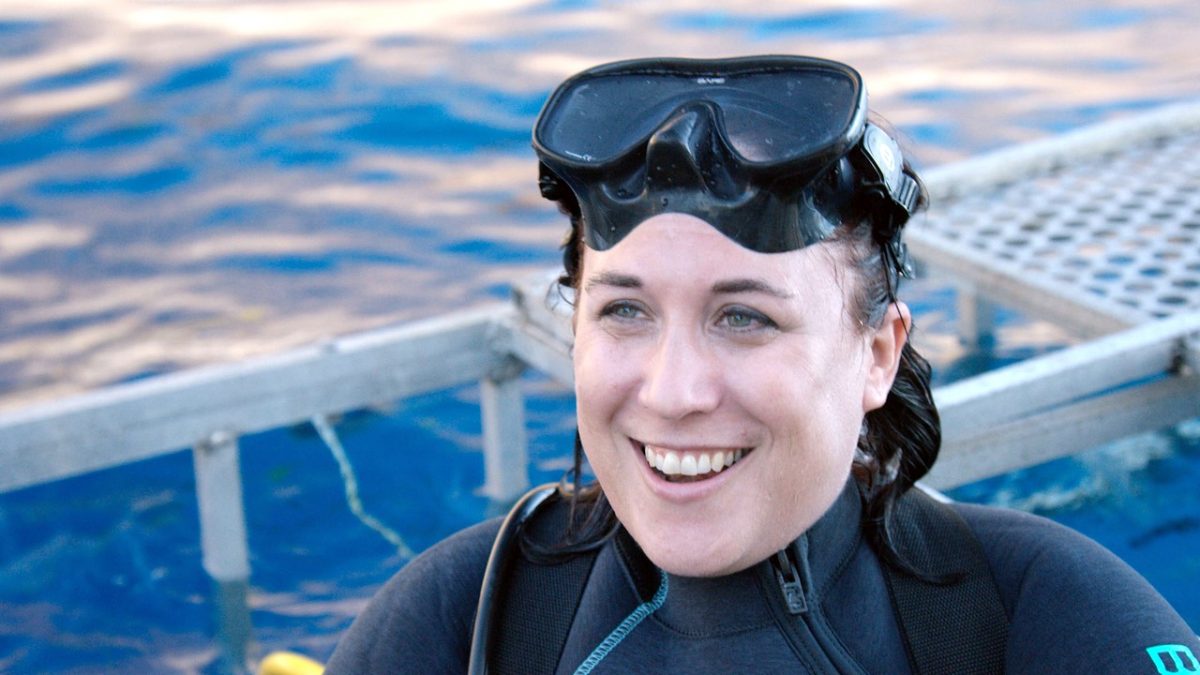Q&A: Toby Daly-Engel Stands For … Persistence
She Frequently Overcomes Obstacles—Both as a Researcher and a Woman in Her Male-Dominated Profession; Aims to Help Others Do the Same
This Q&A is part of a series highlighting Florida Tech faculty, their research and their impact, which takes root on the Space Coast and extends around the globe. For it is not coincidence that brings our stellar faculty members to Florida Tech. It’s passion. Be it landing on Mars or restoring lagoon health, curing illness or protecting personal information, their passions shape our community and create powerful connections among the university, local industries and the world beyond. Faculty research isn’t just part of the job; it’s what they believe in—what they stand for. Exploration. Innovation. Progress. Research for the benefit of all humankind.
Toby Daly-Engel knows that a genetically diverse population is a healthy one. With an ultimate goal of conservation, she and her lab use both molecules and field techniques to study the ecology and evolution of sharks, focusing partly on their reproduction in nursery habitats like the Indian River Lagoon, how that has changed—and will continue to—in response to climate change and how it impacts their genetic diversity.
But becoming the head of her own Shark Conservation Lab has not been without its setbacks—both in her research and in the broader scope of her industry. Persistence, she says, has been the key to overcoming both. As one of few female shark biologists in the world, the ocean engineering and marine sciences assistant professor has become a dogged proponent for diversity among her nonfinned colleagues as well, making the quest for gender parity in her male-dominated field an equally pivotal part of her career.

Credit: John Blackie
Tell us about your research.
I am a molecular ecologist, which means I use the outdoor fieldwork techniques you see on TV—in a boat with the animals and taking DNA samples—and the rest of the time, I’m in a genetics lab, using molecules to study ecology and evolution. In particular, we study the reproduction of sharks and other large migratory marine creatures.
A little background: Sharks can go pretty much anywhere. They can swim thousands of miles, but what’s amazing is that they come back to the same little inshore bays and estuaries—like the Indian River Lagoon—to give birth. We call these ‘nursery grounds,’ and they are these nice, shallow areas that have fewer large sharks to prey on baby sharks and nice small prey that they can eat. So, mama sharks will actually give birth at, in or near these nursery areas, and then they leave again, but the babies stick around for years until they get big enough to join the adult population.
My research on shark reproduction focuses on how sharks are using these inshore nursery habitats and how that’s going to change because of global warming. We know that climate change can affect populations of animals through extinction or by causing them to have to move, which lowers their genetic diversity, which is really important for population health so they can rebound following depletion. We are looking at what types of climate effects cause them to move their nursery habitats so that then, we can take that new understanding of environmental conditions and model it to develop predictions for what’s going to be the critical reproductive habitat these sharks will look for in the future.
We’re also studying the immune effects of climate change. We know that the adaptive immune system first evolved in sharks—the same immune system that is so successful, it has been passed down all the way to us humans and forms the foundation of our ability to make antibodies and tackle modern disease. Many scientists have studied shark immune systems because of the insight they can shed on human medicine, but nobody’s ever used these amazing genes—the precursors of our own—in an ecological context. So, we’re developing maps of shark immune diversity that we can overlay on a physical map of the ocean in a technique called “seascape genetics” that lets us look at the immune response to climate change.
What makes Florida Tech, or the Space Coast in general, the best place to conduct this research?
Our proximity to the environment. Not only do we have one of the biggest nurseries for bull sharks in the world just a mile from our campus, but we’re also just another click to the Atlantic Ocean. So, there is just this amazing natural laboratory right in our backyard.
What’s nice about the Space Coast is that we’re in a place where there are a lot of other types of technologies available, too. Right here, at Florida Tech, technology is being developed to improve underwater monitoring and our understanding of climate conditions, meteorology and satellite data, which we use a lot in our modeling. So, having access to close collaborators who do that stuff—which is amazing and mind-blowing to me—at our institution is really valuable.
Not only do we have one of the biggest nurseries for bull sharks in the world just a mile from our campus, but we’re also just another click to the Atlantic Ocean. So, there is just this amazing natural laboratory right in our backyard.
Dr. Toby Daly-Engel, assistant professor, ocean engineering and marine sciences
Why is your research important?
All of this is important because there’s a lot of conservation concern with sharks. My lab is called the Florida Tech Shark Conservation Lab because even though we’re asking ecological and evolutionary questions and using field tools, lab tools and whatever the question requires, the application of that work is always conservation.
Sharks have some of the slowest reproductive intervals on earth. Some sharks stay pregnant for two entire years, so taking out a population of sharks is like taking out a population of people—they don’t repopulate as quickly as, say, cod or salmon, which can spawn thousands of eggs that turn into thousands of larvae. We estimate that humans kill more than 100 million sharks every year, which is like taking out a third of the U.S population; they’re not going to be there next year. The problem is not just that so many populations and species are under threat, but that there’s even more out there that we just don’t know how they’re doing. There are new species of sharks being discovered every year, and some of these new species are being described after the species itself has gone extinct. So, it’s kind of a race to study some of these species before they disappear.
Why would it matter if sharks were to go extinct?
Sharks are really important for the environment. The biggest sharks are what we call “apex predators,” meaning they’re at the top of the food chain; they have very few natural predators—in fact, their biggest predators are us. But most sharks are not 20 feet long; they’re these little medium-sized things, what we call “mesopredators,” in the middle of the food chain—both predator and prey. But either way, all predators have an important role in the ecosystem, which is keeping the different levels of the food webs—the prey levels—healthy and in check. For instance, lions, or I should say lionesses, they don’t go after the healthiest, fastest young gazelle in the herd. They pick out the old and the sick and the weak and the ones with genetic mutations that probably shouldn’t pass on their DNA to the next generation. And in that way, it’s a kind of population control.
Without that control, all of the other different organisms in the ecosystem will basically eat themselves out of resources. That’s natural selection. With no predators, you can end up with these cascades of extinctions, which can damage entire ecosystems. One reason why I love what I do is that I get to talk to people about sharks and help them understand that yes, they’re scary—and that’s okay, it’s a very instinctual response—but also, they’re cool, and interesting and, most of all, important for the environment.

Yes, you’ve said before that sharks get a bad rap, depicted as these scary, vicious predators. Are shark attacks really that frequent?
There are zero to five shark fatalities in the entire world every year. You are more likely to be killed by a vending machine—or a toilet, a selfie, a Christmas tree, a pig or the Grand Canyon—than a shark. You’re more likely to be hit by lightning three different times than to be bitten by a shark once. You’re actually statistically more likely to be bitten by somebody from New York. …
It’s funny, sharks, just like everybody else, come to Florida in the winter. Depending on the season, there are times of year that when you go into the water, you’re probably no more than 50 yards away from a blacktip shark at any given moment. So, it’s kind of amazing that shark attacks are actually as rare as they are, and it goes to show that they’re just not interested in us as food. We’re not their natural prey—we’re not marine animals—so when a shark attack does happen, it’s a case of mistaken identity.
Part of studying sharks has always been dealing with the characterization of sharks in the media, because that has a huge effect on how people feel about protecting sharks and passing laws to conserve sharks.
What other kinds of outreach do you do?
Aside from doing talks for kids and adults at libraries or on local and national radio or TV, sort of demystifying the notion of sharks as “out to get you,” I’m trying to promote representation for female shark biologists. For instance, before the pandemic, I got to give a talk at the yearly conference for Women in Science and Engineering (WiSE). Speaking with groups like that, to try and recruit women, especially women of color, to the field is a big goal of mine.
Diversity initiatives in shark biology have traditionally lagged because of the macho nature of the work, and that’s slowly changing. When I got my first job, I was one of only two female professors in the country who were conducting fieldwork with sharks. I was also one of the first women to have my own special on Shark Week in 2018, and another one coming up in summer 2021. I don’t love being on TV—I’m sorry, but nobody looks good in a wetsuit. But it’s important to talk to people and show them the reality of what shark science looks like, and who’s really doing it. I’ve persisted when a lot of people told me I couldn’t. I’ve actually been told I’m being “overly persistent,” which is ironic because it’s literally what has made me successful.
There’s still a lack of parity, and above all, a lack of diversity. So yes, helping change the image that people have of sharks, but also of shark biologists, is a huge goal of mine, because of the need to open up opportunities for women in this profession—especially women of color—that we really haven’t had before.
Diversity initiatives in shark biology have traditionally lagged because of the macho nature of the work, and that’s slowly changing. … Helping change the image that people have of sharks, but also of shark biologists, is a huge goal of mine because it opens up opportunities for women in this profession—especially women of color—that we really haven’t had before.
Dr. Toby Daly-Engel, assistant professor, ocean engineering and marine sciences





